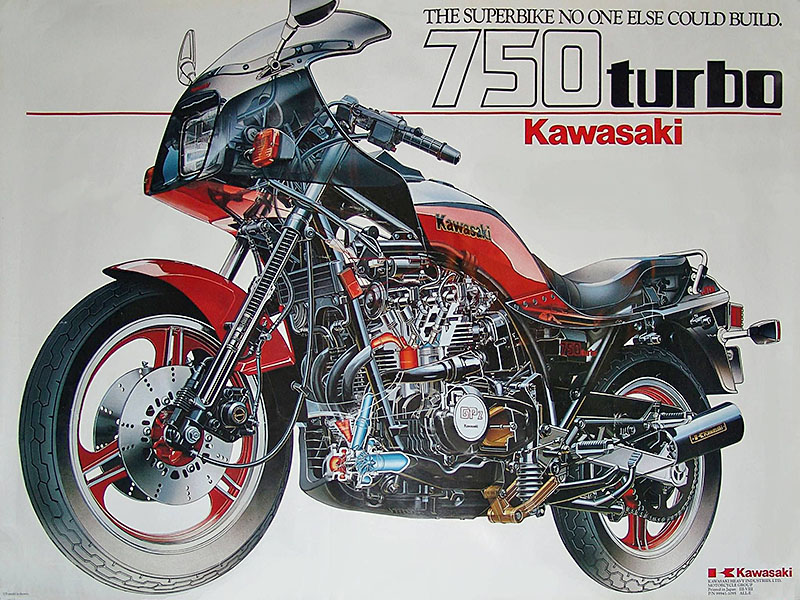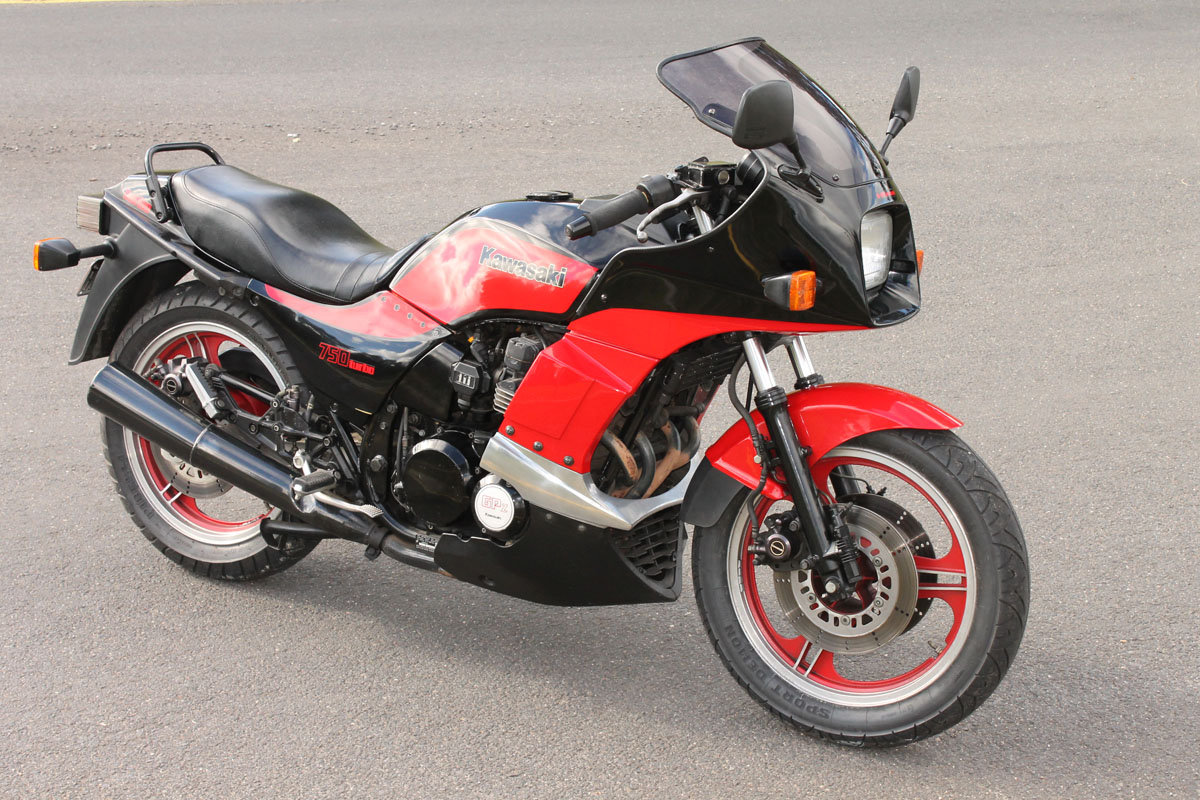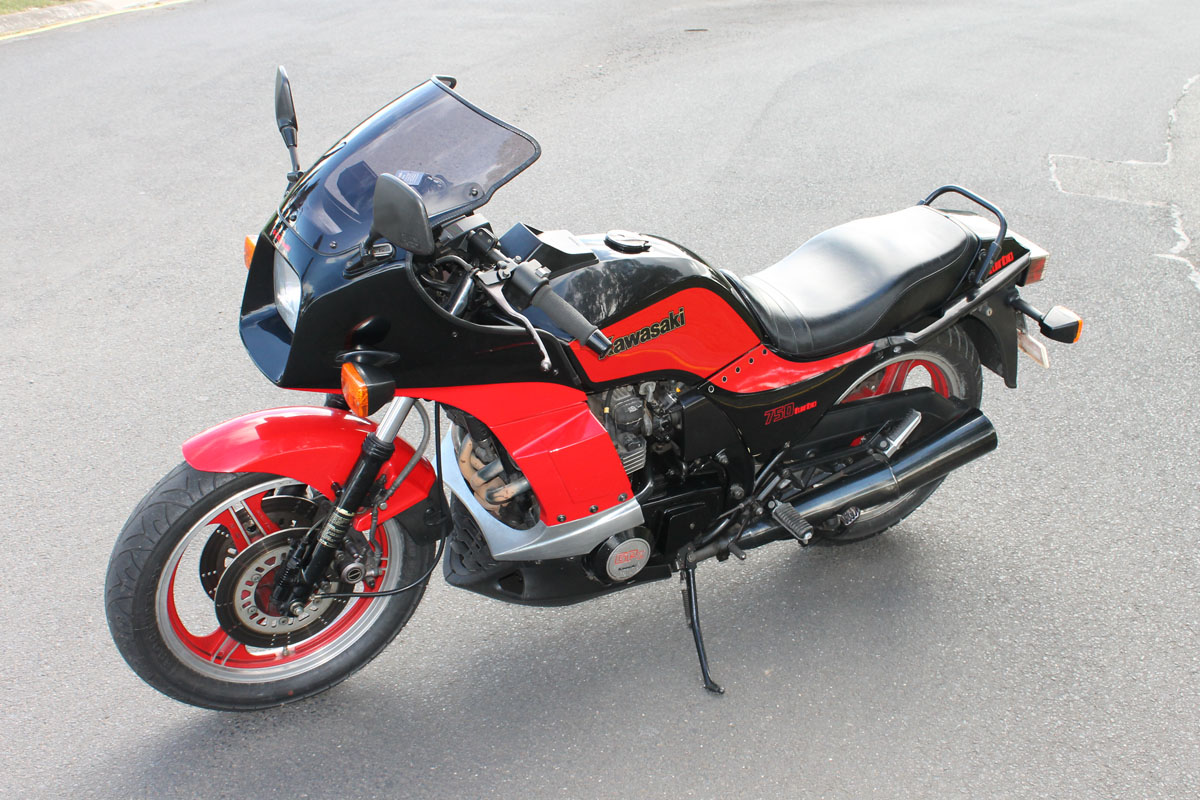Motorcycle Investor mag

Model profile – Kawasaki Turbo GPz750E
(by Guy Allen - updated Oct 2020)
Ever considered adding a turbo bike to the shed? This is the pick of them

Kawasaki’s 2015 launch of the H2 and H2R supercharged techno flaghships rightly created plenty of interest, but was far from being the first time the company dabbled in forced induction motorcycles...
You have to remember back to the early 1980s, when bikes like Kawasaki GPz1100 and Suzuki GSX1100 roamed the earth. The Japanese makers at the time were undergoing what proved to be a near-suicidal development race, where a dizzying array of new models were being released. That and some questionable business practices – they were accused at federal government level of force-feeding the USA market – were very nearly disastrous for one of two makers. There was talk of at least one of them being on the verge of bankruptcy. That’s hard to imagine now, but gives you a sense of how dire the situation became.
A spin-off of the retail wars was the incredibly brief appearance of the turbo bikes. Honda started with the wonderfully complex CX500T (followed by a 650 version), then Yamaha pitched in with the XJ650 turbo, Suzuki with the XN85 (actually a 650-four) and, last of all, Kawasaki with the ZX750E aka the GPz750T.
We’re talking a launch in 1983 for the 1984 and 1985 model years. There were in fact two variants – B1 and B2 – though the differences are very minor: dual throttle cables on the later model and different brake caliper stickers.
The attraction of a turbo was easy to see: you get a lot more horsepower in a compact package. The downside was you also get more complexity and, at the time when these bikes were developed, throttle lag (where the turbo takes a while to build up pressure and respond to the right wrist) was a serious issue.

Turbos were also making inroads in the car world, but even there the technology was relatively crude and in need of a lot more development. They certainly weren’t anywhere near as common as they are now.
Kawasaki was the last of the Japanese factories to produce a turbo, which had advantages and disadvantages. The advantage was it got to sit back a little and try to avoid the mistakes made by others. On the negative side, by the time they rolled out their toy the market was well on its way to deciding that turbos weren’t such a great idea.
So what were the issues? The biggest was the competition from the makers’ own catalogues. A full-sized conventional 1100 had a better spread of power, was almost as fast on top end acceleration and was far less complex. And none were game to release an 1100 with a turbo – probably just as well, given the questionable chassis available at the time.
A few years back I went nuts and bought one of these things, though it’s since been sold.
What’s it like? Surprisingly little and low. The air-cooled engine feels and sounds pretty agricultural by today’s standards and doesn’t really do much to impress as you tiptoe your way through the traffic. It’s okay, but I’d much rather have a conventional 1100 in these circumstances.
Go and find enough room to play. The first time it gets wound up you risk getting so engrossed in watching the turbo boost gauge that you completely forget the tacho and speedo. This is Dr Jekyll and Mr Hyde with wheels. One minute it’s a rather gruff mid-weight, the next it smooths out, picks up its proverbial skirts and rockets at the horizon at an unbelievable rate. Around 5000-6000 is where the transformation takes place and it really is dramatic. Suddenly it starts to feel a little like a modern performance bike.
A bloke I know, Harold Holt (no, not that Harold), was a Kawasaki salesman at the time these were launched. He owned a GPz1100 and reckons the turbo had more acceleration. I can believe it.
So what’s the catch? Definitely the 1980s chassis. The frame holds together well enough, but the combination of clip-on-like handlebars with very heavy steering is weird at city speeds. It comes together a whole lot better at highway pace.

The centrestand is a damn nuisance, restricting cornering clearance. My biggest beef is with the brakes. They’re just not up to the job and feel a good ten years behind the performance. You really have to think twice about where you cut loose the engine as the stoppers are easily overwhelmed.
In its day, the Zed claimed a 220km/h top speed and 11.5sec quarter mile – very respectable numbers, particularly for a ‘mere’ 750. There is more performance said to be readily available via a remarkably simple mod. The popular theory is that Kawasaki didn’t want this bike to overshadow and outperform its soon-to-be-released GPz900R, which was a far more important model in the grand corporate scheme.
So, the stock turbo was restricted to 10.5psi boost. That apparently more than doubles if you unhook the brown wire from the engine management unit in the tail. This, with one or two other subtle mods, is supposed to switch the tuning to ‘race’ mode and we’re told the difference is staggering. If only you could do the same with the brakes.
The question would be just how much that mod shortens the engine life. I’m not sure I’d bother.
Reliability is pretty good and there are plenty of specialists out there who can rebuild a turbo unit. And it is a specialist job, requiring a proper ‘clean room’. One issue is the ignitor unit under the seat can be prone to cracking its case. That isn’t overly common, but treat any bike that runs rough with suspicion.
As with a lot of rare models, cosmetic parts could turn out to be the biggest issue for a restorer. Therefore a good original bike is worth paying a premium for.
How much? They don’t come up for sale very often, but I’d be expecting up to mid teens for a decent one.
There are better handling and faster bikes out there, but the Zed turbo is an interesting piece of history and fun to play with on a back road. It’s one of those bikes that should be welcome in any collection.

See the story on our own 750 Turbo here

The other Kwaka turbo
Though not sanctioned by head office, there was a previous Kawasaki turbo, called the Z1000TC. This was developed in the USA from 1978, by former Kawasaki marketing director Alan Masek. It employed a Rayjay turbo unit and was sold through a small number of Kawasaki dealers. Some examples have made it to this country.
The original batch of 250 was done in the silver livery of the host bike, while a further 250 was completed in the now famous colurful graphics shown above, which were designed by Rollin 'Molly' Sanders.
Performance was said to be a 220km/h top speed with a 10.9sec quarter mile time.
Just to confuse matters, Kawasaki New Zealand is said to have imported 13 of the kits and fitted them to Z1-Rs, this creating the Z1-R1000TC.
See more on the Z1-R series, including the turbos, here.

Specifications
Kawasaki ZX750E turbo
ENGINE
Type: air-cooled in-line four with two valves per cylinder
Bore and Stroke: 66 x 54mm
Displacement: 738cc
Compression ratio: 7.8:1
Fuel system: digital fuel injection with turbocharger
TRANSMISSION
Type: 5-speed constant mesh
Final drive: chain
CHASSIS & RUNNING GEAR
Frame type: Twin-loop steel
Front suspension: 37mm fork, air preload, adjustable anti-dive
Rear suspension: monoshock, air preload, adjustable rebound
Front brakes: twin 1-piston 280mm twin discs
Rear brake: 1-piston, 270mm disc
DIMENSIONS & CAPACITIES
Dry weight: 233kg
Seat height: 780
Fuel capacity: 17lt
PERFORMANCE
Max power: 112hp @ 9000rpm
Max torque: 99.1Nm @6500rpm
Top Speed: 220km/h
OTHER STUFF
Price when new: $4900 plus ORC
Now: up to $15,000
Good
Fast for its day
Unusual
Collectible
Not so good
Woeful brakes
Gothic handling
-------------------------------------------------
Produced by AllMoto 61 400 694 722
Privacy: we do not collect cookies or any other data.


Archives
Contact


